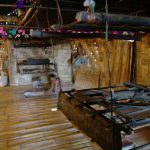42 kilometers and 2 hours drive from Mon Village, on extremely rough roads, which are brutal to the spine, there lies the remote village of Longwa – right on top of the numerous hills and only a few foot-steps from the border to Myanmar, the former Burma. It is the home of one of the six highest Naga kings. Before visiting his village, you need to speak to the village chief first, which in our case was the father of the 30 year-old King, and ask for permission. Only after he has offered you his hospitality, are you allowed to offer your present to him. We luckily picked the right one by handing him over a big bag of oranges, strong Assam tea-leaves and some biscuits for the uncountable kids. Happy with everything, he was leading us towards the biggest house of the village, positioned on the highest and most exposed spot: half of it stands on Indian territory and the other half stands on Burmese territory, with only but a border stone deviding the two countries, no official border, no sign posts, no soldiers – it is the King’s house: and a construction of bamboo and wood.
Architecture:
The main structure of longhouse, which can expand up to at least 30 meters in length and about 12 meters in width, is made from wood, while the walls are entirely made from bamboo wickerwork. It has a thatched roof, no windows, and only 2 doors – one on each side of the building, some of which are artfully decorated with totems and sculls. The roof often has some special decorative pendants made from straw, bamboo or cane. The bigger houses often also keep a longdrum and a mill in the vestibule. Inside, the flooring is nothing but rammed clay.
There are 3 rooms in a house of the king: 1 sleeping room for the king and his queen (their direct kids sleep with the other sub-wives in an extra house), one big kitchen with bamboo-cupboards with weaved baskets to keep the food and an enormous open fire-place with a wooden frame hanging from the ceiling, holding the necessery kitchen equipment, like enamelled pots, bamboo sieves, ladles and so on, and a 3. room, the exhibition hall for representation: here, all prestigious things are being displayed: a few very huge gongs of pure gold, measuring up to 120 cm in diameter and weighing tons!, trophies of the most biggest mithuns – a huge and very strong animal, half wild gaur and half domesticated cow with enourmous horns, that represent wealth – the more horns you have, the bigger your influence. Then, huge ivory tusks, hundreds of precious and semi-precious stones, six-foot high wood carvings made from one piece of wood, used as a pillar to hold the ceiling, and so on – just unbelievable!
Tribe:
The Naga tribes can be found all along the Burmese border. Their villages are always placed on top of a hill, so the enemy can be seen and thus defeated more easily. The 16 main tribes speak their own language and numerous dialects, whereas all speak Nagamese. Formerly, it was a warrior tribe, enlarging their territory by invading other villages and beheading the inhabitants. By possessing the head of the enemies they possessed their power, so they believed. Afterwards it was placed in front of the warrior’s house and he was entitled to add a pendant in form of a bronze-head to his necklace. Only the brave ones were also allowed to wear a tatoo on the face and down the body – but, it was not only a sign for bravery, but also an important symbol of status, a social privilege. To make sure that the clans did not get mixed up on the killing fields, every clan had his own tatoo painting.
Apart from tatoos and scull-pendants, they nowadays still wear on special or official occasions a headgear decorated with hornbill feathers, rabbit fur and teeth of wild boar. When going hunting they carry a cane basket, bow and arrow, and a big knife along with them.
Headhunting was going on until the end of 1960, after Christianization more or less put an end to it. Although they have put up many Baptist churches, they are animists by heart. Can you believe that almost 99% of Naga people are nowadays Christians?
Most of the sculls from former times have been buried by the Church in the last decades, but there are still some hundreds of sculls left over…
History:
In former times, none of the colonial occupants was able to dominate the Naga; no-one came further than Assam. As the Naga tribe always was autonomous, of course it was hard for them when India took over after independency in 1947 and ruled them. Consequently, many and heavy fights took place, and eventually Indian troops invaded the area and burned down whole villages and shot down their inhabitants. You will find no Naga-family, which has not lost at least one family member in those times….
Nowadays, they have found a reasonable agreement with the Indian government, but the desire to be an independent state one day, has not faded.
Concerning the social structure, the momentary king, a Konyak of around 30 years of age, reigns, but there are another 6 more kings within Nagaland. Each of them taking care of about 50 villages, which themselves have numerous deputy kings/chiefs; parallel they are administered by a government council. Important issues are being decided by all of them together – but in the end, the king always has the last word. There are 16 main tribes, but numerous sub-tribes, built by smaller clans.
Social life:
Their marriages are love marriages, preferrably within their own tribe and clan, and most commonly they are around 25-30 years of age. Women in this case, are being asked by a man and, in order to say „I will“, weave a scarf for their husbands-to-be. They live a monogamous life, and only the king is allowed to polygamy, with sometimes as many as 60 women and consequently half a regiment on children! Once he chooses this main wife, he will call her „Queen“ and from this moment on all the other wives have to take on a subordinate role. A village therefore, is composed of a network of all the married families and their relatives.
Nowadays, when going hunting, they shoot and eat „everything that moves except cars“, (leaving out human beings, of course)… that is: frogs, snails, reptiles, monkeys,worms, grubs, maggots, birds and so on… – it is no surprise, that you cannot hear the sound of birds in their neighbourhood any more or, see butterflies …. Reason enough, why in April 2009 hunting birds was forbidden by law – but who is controlling it?
The people in those remote areas are still very shy. They lead a simple life, doing farming, going hunting and growing vegetables, bananas, citrus fruits and corn on their small fields surrounding their farmhouses.
There is only one road, the main road, and all the farmhouses lie either to the right-hand or to the left-hand side. You can hardly find any cars. Every village is being kept clean. It comprises a washing place, a slaughter place, a church, a school, a medical center and – often – a mareng, a house for the initiation rites of boys: from puberty to marriage, all village boys start living together in this house, being looked after and cared for by an old and wise warrior chosen by the „council of the elders“, who teaches them the „lessons of life“ and introduces them to all the essential things concerning men’s affairs.
Every February the villages celebrate the traditional Bisani, where, under the motto „cleansing and purification“, the whole village is being cleaned and shrubbed, together with every corner of the houses, the water tanks, the animal shelters etc, including, of course, all inhabitants – from head to toe!
Every now and then, some villagers from Burma passes by in order to socialize a bit and sit with the village elders to have an opium pipe, talk about hunting grounds or, do a bit of trading and exchanging of goods.
Indian government officials only show up rarely and in fact, they leave them more or less, on their own – which, on the other hand gives the tribal people peace of mind.
As the old headhunters with their distinct tatoos are dying out, all that is being left, are old time memories and stories of their warrior time.
All for now – if you liked it, please like it and follow!
Next time it will be about the Northeast Indian Apatani tribe – another extremely interesting animist tribe from Arunachal Pradesh, wearing extraordinary nose piercings, believing in the Sun and the Moon…





